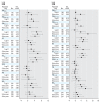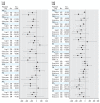Circulating biomarkers of inflammation, antioxidant activity, and platelet activation are associated with primary combustion aerosols in subjects with coronary artery disease
- PMID: 18629312
- PMCID: PMC2453158
- DOI: 10.1289/ehp.11189
Circulating biomarkers of inflammation, antioxidant activity, and platelet activation are associated with primary combustion aerosols in subjects with coronary artery disease
Abstract
Background: Biomarkers of systemic inflammation have been associated with risk of cardiovascular morbidity and mortality.
Objectives: We aimed to clarify associations of particulate matter (PM) air pollution with systemic inflammation using models based on size-fractionated PM mass and markers of primary and secondary aerosols.
Methods: We followed a panel of 29 nonsmoking elderly subjects with a history of coronary artery disease (CAD) living in retirement communities in the Los Angeles, California, air basin. Blood plasma biomarkers were measured weekly over 12 weeks and included C-reactive protein (CRP), fibrinogen, tumor necrosis factor-alpha (TNF-alpha) and its soluble receptor-II (sTNF-RII), interleukin-6 (IL-6) and its soluble receptor (IL-6sR), fibrin D-dimer, soluble platelet selectin (sP-selectin), soluble vascular cell adhesion molecule-1 (sVCAM-1), intracellular adhesion molecule-1 (sICAM-1), and myeloperoxidase (MPO). To assess changes in antioxidant capacity, we assayed erythrocyte lysates for glutathione peroxidase-1 (GPx-1) and copper-zinc superoxide dismutase (Cu,Zn-SOD) activities. We measured indoor and outdoor home daily size-fractionated PM mass, and hourly pollutant gases, total particle number (PN), fine PM elemental carbon (EC) and organic carbon (OC), estimated secondary organic aerosol (SOA) and primary OC (OCpri) from total OC, and black carbon (BC). We analyzed data with mixed models controlling for temperature and excluding weeks with infections.
Results: We found significant positive associations for CRP, IL-6, sTNF-RII, and sP-selectin with outdoor and/or indoor concentrations of quasi-ultrafine PM < or = 0.25 microm in diameter, EC, OCpri, BC, PN, carbon monoxide, and nitrogen dioxide from the current-day and multiday averages. We found consistent positive but largely nonsignificant coefficients for TNF-alpha, sVCAM-1, and sICAM-1, but not fibrinogen, IL-6sR, or D-dimer. We found inverse associations for erythrocyte Cu,Zn-SOD with these pollutants and other PM size fractions (0.25-2.5 and 2.5-10 microm). Inverse associations of GPx-1 and MPO with pollutants were largely nonsignificant. Indoor associations were often stronger for estimated indoor EC, OCpri, and PN of outdoor origin than for uncharacterized indoor measurements. There was no evidence for positive associations with SOA.
Conclusions: Results suggest that traffic emission sources of OCpri and quasi-ultrafine particles lead to increased systemic inflammation and platelet activation and decreased antioxidant enzyme activity in elderly people with CAD.
Keywords: acute-phase proteins; cytokines; enzymes; epidemiology; longitudinal data analysis; oxidative stress; panel study; particulate air pollution.
Figures




References
-
- Arhami M, Kuhn T, Fine PM, Delfino RJ, Sioutas C. Effects of sampling artifacts and operating parameters on the performance of a semi-continuous particulate EC/OC monitor. Environ Sci Technol. 2006;40:945–953. - PubMed
-
- Bender R, Lange S. Adjusting for multiple testing—when and how? J Clin Epidemiol. 2001;54:343–349. - PubMed
-
- Cabada JC, Pandis SN, Subramanian R, Robinson AL, Polidori A, Turpin B. Estimating the secondary organic aerosol contribution to PM2.5 using the EC tracer method. Aerosol Sci Technol. 2004;38:140–155.
-
- Cho AK, Sioutas C, Schmitz DA, Kumagai Y, Singh M, Miguel AH, et al. Redox activity of airborne particulate matter at different sites in the Los Angeles Basin. Environ Res. 2005;99:40–47. - PubMed
-
- Chuang KJ, Chan CC, Su TC, Lee CT, Tang CS. The effect of urban air pollution on inflammation, oxidative stress, coagulation, and autonomic dysfunction in young adults. Am J Respir Crit Care Med. 2007;176:370–376. - PubMed
Publication types
MeSH terms
Substances
Grants and funding
LinkOut - more resources
Full Text Sources
Medical
Research Materials
Miscellaneous

